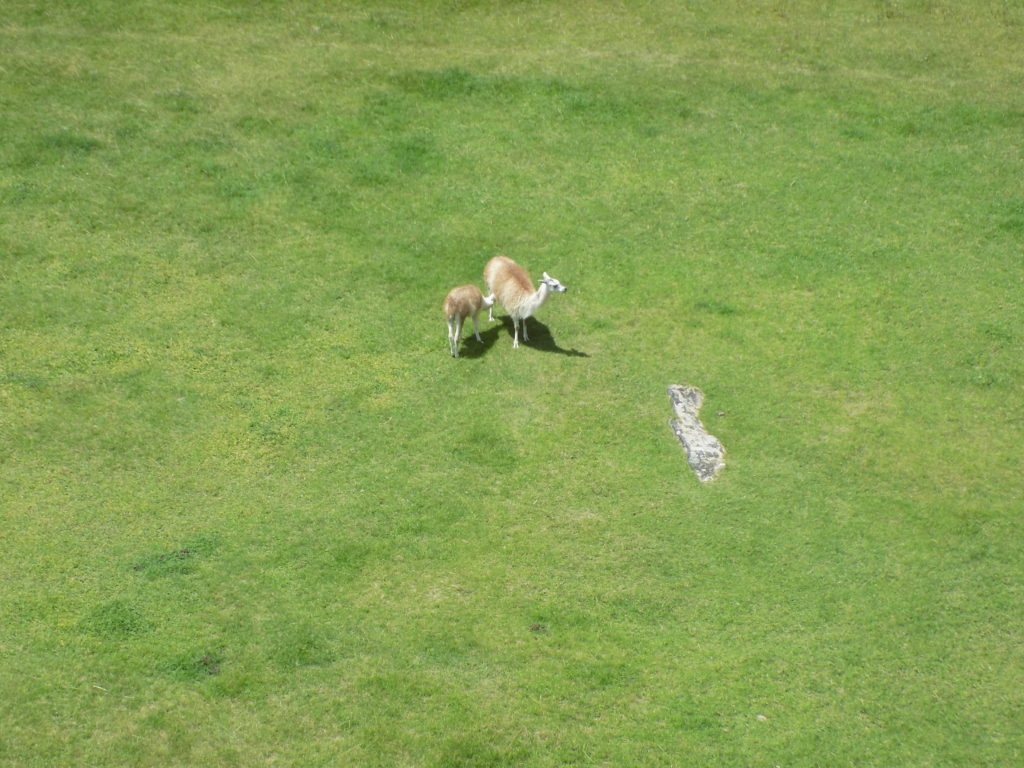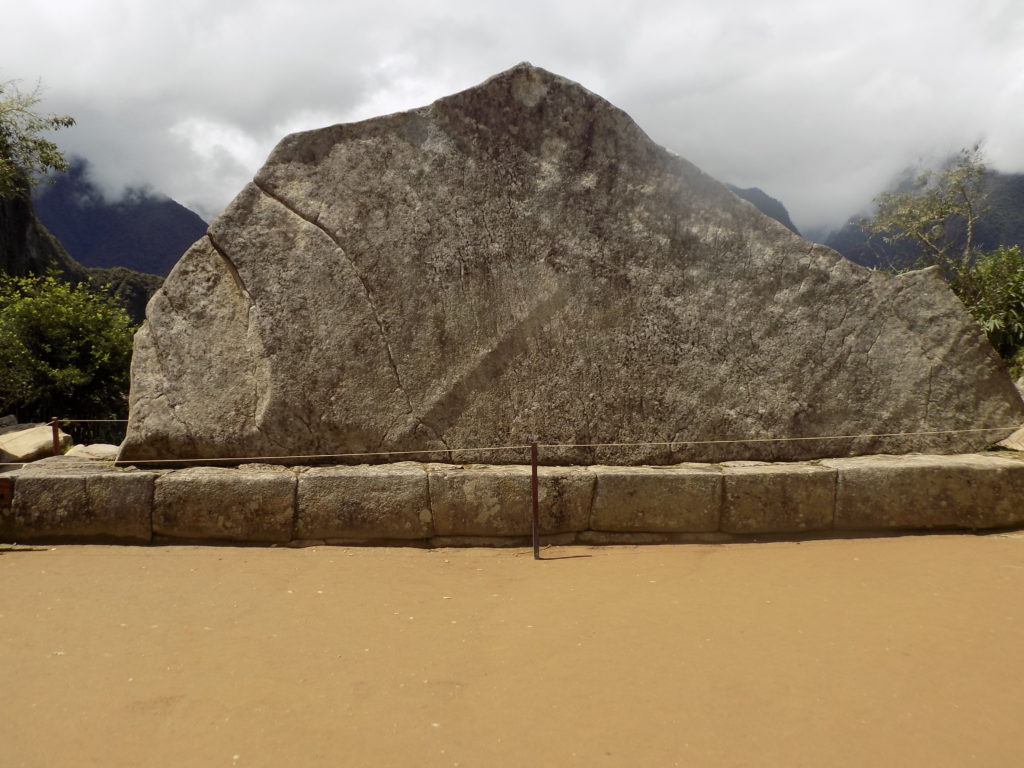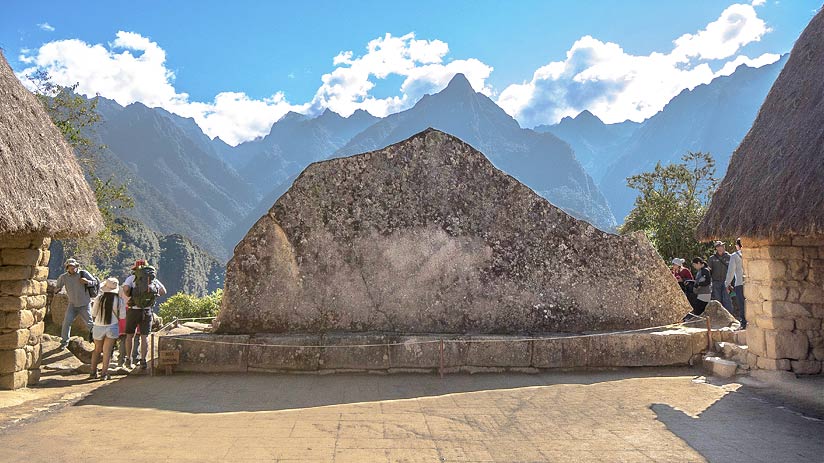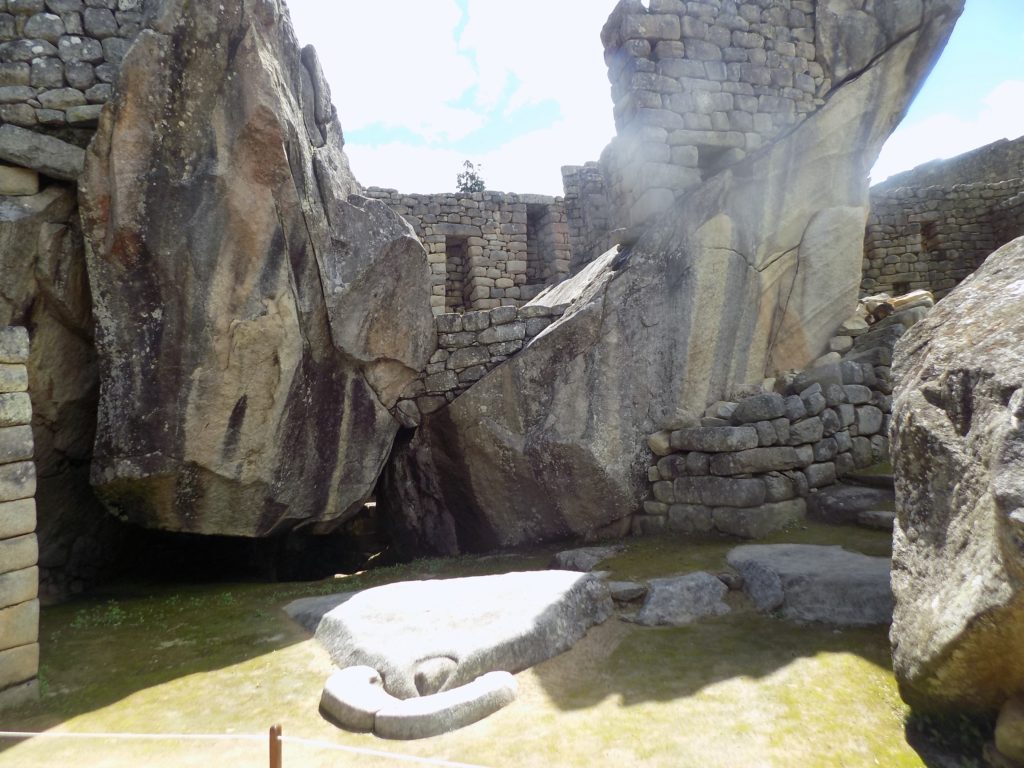The Main Plaza.
The area of Machu Picchu called the Main Plaza is hard to miss. It appears in nearly every iconic photo of the complex and its broad grassy expanse, unique by is very openness, is visible from nearly everywhere on the allowable tourist path.
As it has been with everything else, we can only guess what its purpose or purposes might have been. Assuming this was a royal retreat that housed between 500 and 1,000 people, it’s possible that this area could have served as a space where everyone could assemble perhaps for some sort of ritual celebration. It’s more likely that it served as a space to clearly delineate the upper Hanan section where the elite would have resided and where all the sacred sites were built from the lower Hurin section where the working class would have lived.
Today, as you can see, it is tended by llamas – including nursing ones.
The Sacred Rock.
One of the most interesting and enigmatic features of Machu Picchu is the one called the Sacred Rock. Not only is its purpose as subject to speculation as most of the other structures but it is also the one that has the broadest range of imagined shapes. One of the Quechua words applied to it is wank’a, which means statue, so its shape seems deliberate. Given that the nearly three-meter-tall rock sits on a rectangular base that’s seven meters long, calling it a statue seems beyond reasonable.
The placement of the rock indicates that it might have served some geographic purpose. It sits at the northernmost edge of the site and has a path leading to (or from) Wayna Picchu and might have symbolically connected the two mountains.
You can see the large, flattened space in front of the base smoothed in a way similar to that which we saw in front of the Main Temple. It’s flanked by a pair of three-sided stone structures that have been restored by the Ministry of Culture. Taken in combination, it indicates that the area could have served as a shrine where rituals and offerings to Pacha Mama might have been performed. The shelters could have been a place where people stayed during an extended ritual or they could have been a place where they prepared their offerings with the flat area in front of the rock itself being the place they made them.
Now, let’s talk about pareidolia starting with a story Berner told us. He talked about two groups of workers, one from the mountains and one from the coast. Asked if they saw any shape to the rock, the ones from the mountains saw a shape familiar to them – a cuy (guinea pig) – while the ones from the coast saw something more closely related to their experience – a fish. Start at the right to see the head of the cuy and at the left to see the fish.
Another interpretation is that it is a representation of the mountain called Pumasillo some 25 kilometers southwest of Machu Picchu. This has been inferred by some archaeologists by both the shape of the stone and the symbolic importance of the puma.
To me, the most plausible explanation appears when the day is clearer than when I took the photo above. Under those clear conditions, the scene would look more like the one seen in the picture below from the website machupicchutravel
where the rock resembles the mountains behind it particularly the peak called Yanatin directly behind it. Even when we don’t know, sometimes, the simplest explanation is the best.
Temple of the Condor.
Our next, and final, stop is at the Temple of the Condor. I’ve previously noted that the condor holds a significant place in Andean cosmology. It’s symbolic of the Hanan Pacha or upper world. Through this symbolism it connects to spiritual elevation and overcoming negativity in life. The bird was also a fertility symbol for the Inkas. They believed that with the movement of its wings, the condor could gather clouds together to produce rain. Thus, it should be no surprise that the priests – if not Pachakutiq himself – would insist on including a temple for it on the site.
Its location at Machu Picchu was almost certainly neither a random nor coincidental choice. Sited in the southeast corner of the upper sector, the temple takes full advantage of the natural shape of a rock formation that had been eroding for millions of years to create the condor’s wings.
It’s possible that the head could have been used as an altar.
Our tour ends here and, while I hope it’s been memorable, this walk through Machu Picchu is far from a complete exploration of the site. We didn’t visit the upper cemetery and the famous funerary rock, the Group of Three Doorways, explore the royal enclosures including the Casa Ñusta (Palace of the Sun Princess), or look closely at the Liturgical Fountains. Though Berner pointed them out to us, we saw them only from a distance and they are not, therefore, a part of this tour.
There’s always more to see and more to learn. And while reading and looking at photos can be helpful, no words can fully communicate the thrill of the experience and no photographs can replicate that which our eyes see. In short, there’s no substitute for personal exploration.
And in case all you disco kings and queens have forgotten, this is how the title of the previous posts connect with the title of the two parts of this one.




